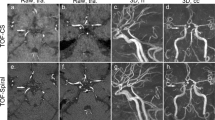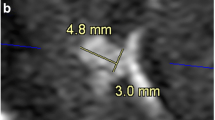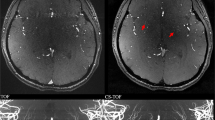Abstract
Introduction
We aimed to investigate the utility of compressed sensing time-of-flight magnetic resonance angiography (CS TOF-MRA) for diagnosing intracranial and cervical arterial stenosis by using digital subtraction angiography (DSA) as the reference standard.
Methods
Thirty-seven patients with head and neck arterial stenoses who underwent CS TOF-MRA and DSA were retrospectively enrolled. The reconstructed resolution of CS TOF-MRA was 0.4 × 0.4 × 0.4 mm3. The scan time was 5 min and 2 s. The image quality of CS TOF-MRA was independently ranked by two neuroradiologists in 1031 arterial segments. The luminal stenosis grades on CS TOF-MRA and DSA were analyzed in 61 arterial segments and were compared using the Wilcoxon signed-rank test. The ability of CS TOF-MRA to predict moderate to severe stenosis or occlusion was analyzed.
Results
The image quality of most arterial segments (95.2%) on CS TOF-MRA was excellent. Arterial segments with low image quality were mainly the V3–4 segments of the vertebral artery. The majority of arterial stenoses (62.3%) were located in the cervical internal carotid artery. The luminal stenosis grades of CS TOF-MRA were concordant with that of DSA in 50 of 61 segments (p = 0.366). CS TOF-MRA had a sensitivity of 84.4% and a specificity of 88.5% for predicting moderate to severe stenosis. For detecting occlusion lesions, it had a sensitivity of 100% and a specificity of 94.1%.
Conclusion
CS TOF-MRA provides adequate image quality within a reasonable acquisition time and is a reliable tool for diagnosing head and neck arterial steno-occlusive disease.
Key Points
• CS TOF-MRA provides a relatively large coverage (16 cm), high resolution (0.4 × 0.4 × 0.4 mm 3 ) and good image quality of head and neck arteries within 5 min and 2 s.
• The diagnostic accuracy of CS TOF-MRA in the assessment of moderate to severe stenosis and occlusion was comparable with that of DSA.
• Arterial segments with low image quality were mainly the V3 and V4 segments of the vertebral artery.

Similar content being viewed by others
Abbreviations
- ACA:
-
Anterior cerebral artery
- BA:
-
Basilar artery
- CS TOF-MRA:
-
Compressed sensing time-of-flight magnetic resonance angiography
- DSA:
-
Digital subtraction angiography
- ICA:
-
Internal carotid artery
- MCA:
-
Middle cerebral artery
- mFISTA:
-
Modified fast iterative shrinkage-thresholding algorithm
- NASCET:
-
North American Symptomatic Carotid Endarterectomy Trial
- PCA:
-
Posterior cerebral artery
- PI:
-
Parallel imaging
- SNR:
-
Signal-to-noise ratio
- VA:
-
Vertebral artery
- WASID:
-
Warfarin Aspirin Symptomatic Intracranial Disease
References
Johnston SC, Mendis S, Mathers CD (2009) Global variation in stroke burden and mortality: estimates from monitoring, surveillance, and modelling. Lancet Neurol 8:345–354
Willinsky RA, Taylor SM, TerBrugge K, Farb RI, Tomlinson G, Montanera W (2003) Neurologic complications of cerebral angiography: prospective analysis of 2,899 procedures and review of the literature. Radiology 227:522–528
Patel MR, Klufas RA, Kim D, Edelman RR, Kent KC (1994) MR angiography of the carotid bifurcation: artifacts and limitations. AJR Am J Roentgenol 162:1431–1437
Boussel L, Herigault G, de la Vega A, Nonent M, Douek PC, Serfaty JM (2006) Swallowing, arterial pulsation, and breathing induce motion artifacts in carotid artery MRI. J Magn Reson Imaging 23:413–415
Larkman DJ, Nunes RG (2007) Parallel magnetic resonance imaging. Phys Med Biol 52:R15–R55
Hollingsworth K (2015) Reducing acquisition time in clinical MRI by data undersampling and compressed sensing reconstruction. Phys Med Biol 60:R297–R322
Milles J, Versluis JM, Webb A, Reiber J (2010) Quantitative evaluation of compressed sensing in MRI: application to 7T time-of-flight angiography. Proceedings of the 10th IEEE International Conference on Information Technology and Applications in Biomedicine, Corfu, 2010, pp. 1–4
Lustig M, Donoho D, Pauly JM (2007) Sparse MRI: the application of compressed sensing for rapid MR imaging. Magn Reson Med 58:1182–1195
Li B, Li H, Dong L, Huang G (2017) Fast carotid artery MR angiography with compressed sensing based three-dimensional time-of-flight sequence. Magn Reson Imaging 43:129–135
Fushimi Y, Fujimoto K, Okada T et al (2016) Compressed sensing 3-dimensional time-of-flight magnetic resonance angiography for cerebral aneurysms: optimization and evaluation. Invest Radiol 51:228–235
Lu SS, Qi M, Zhang X et al (2018) Clinical evaluation of highly accelerated compressed sensing time-of-flight MR angiography for intracranial arterial stenosis. AJNR Am J Neuroradiol 39:1833–1838
Beck A, Teboulle M (2009) A fast iterative shrinkage-Thresholding algorithm for linear inverse problems. SIAM J Imaging Sci 2:183–202
(1991) North American Symptomatic Carotid Endarterectomy Trial. Methods, patient characteristics, and progress. Stroke 22:711–720. https://doi.org/10.1161/01.STR.22.6.711
Anderson CM, Saloner D, Tsuruda JS, Shapeero LG, Lee RE (1990) Artifacts in maximum-intensity-projection display of MR angiograms. AJR Am J Roentgenol 154:623–629
Choi CG, Lee DH, Lee JH et al (2007) Detection of intracranial atherosclerotic steno-occlusive disease with 3D time-of-flight magnetic resonance angiography with sensitivity encoding at 3T. AJNR Am J Neuroradiol 28:439–446
Nederkoorn PJ, van der Graaf Y, Eikelboom BC, van der Lugt A, Bartels LW, Mali WP (2002) Time-of-flight MR angiography of carotid artery stenosis: does a flow void represent severe stenosis? AJNR Am J Neuroradiol 23:1779–1784
Serfaty JM, Chirossel P, Chevallier JM, Ecochard R, Froment JC, Douek PC (2000) Accuracy of three-dimensional gadolinium-enhanced MR angiography in the assessment of extracranial carotid artery disease. AJR Am J Roentgenol 175:455–463
Sadikin C, Teng MM, Chen TY et al (2007) The current role of 1.5T non-contrast 3D time-of-flight magnetic resonance angiography to detect intracranial steno-occlusive disease. J Formos Med Assoc 106:691–699
Hirai T, Korogi Y, Ono K et al (2002) Prospective evaluation of suspected stenoocclusive disease of the intracranial artery: combined MR angiography and CT angiography compared with digital subtraction angiography. AJNR Am J Neuroradiol 23:93–101
Nederkoorn PJ, Elgersma OE, Mali WP, Eikelboom BC, Kappelle LJ, van der Graaf Y (2002) Overestimation of carotid artery stenosis with magnetic resonance angiography compared with digital subtraction angiography. J Vasc Surg 36:806–813
Huston J 3rd, Lewis BD, Wiebers DO, Meyer FB, Riederer SJ, Weaver AL (1993) Carotid artery: prospective blinded comparison of two-dimensional time-of-flight MR angiography with conventional angiography and duplex US. Radiology 186:339–344
Samuels OB, Joseph GJ, Lynn MJ, Smith HA, Chimowitz MI (2000) A standardized method for measuring intracranial arterial stenosis. AJNR Am J Neuroradiol 21:643–646
Funding
This study has not received any funding.
Author information
Authors and Affiliations
Corresponding authors
Ethics declarations
Guarantor
The scientific guarantor of this publication is Xun Ning Hong.
Conflict of interest
Authors Yi Sun, Michaela Schmidt, Christoph Forman, and Peter Speier are employees of Siemens Healthcare. The remaining authors of this manuscript declare no relationships with any companies whose products or services may be related to the subject matter of the article.
Statistics and biometry
No complex statistical methods were necessary for this paper.
Informed consent
Written informed consent was waived by the Institutional Review Board.
Ethical approval
Institutional Review Board approval was obtained.
Methodology
• Retrospective
• Performed at one institution
Additional information
Publisher’s note
Springer Nature remains neutral with regard to jurisdictional claims in published maps and institutional affiliations.
Electronic supplementary material
ESM 1
(DOCX 2576 kb)
Rights and permissions
About this article
Cite this article
Zhang, X., Cao, Y.Z., Mu, X.H. et al. Highly accelerated compressed sensing time-of-flight magnetic resonance angiography may be reliable for diagnosing head and neck arterial steno-occlusive disease: a comparative study with digital subtraction angiography. Eur Radiol 30, 3059–3065 (2020). https://doi.org/10.1007/s00330-020-06682-3
Received:
Revised:
Accepted:
Published:
Issue Date:
DOI: https://doi.org/10.1007/s00330-020-06682-3




